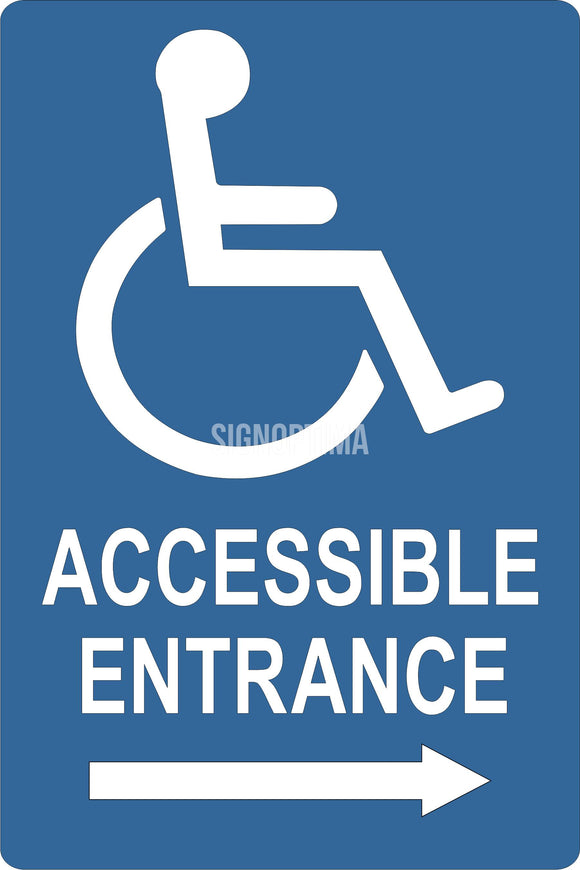Just How ADA Signs Boost Availability for Everyone
Just How ADA Signs Boost Availability for Everyone
Blog Article
Checking Out the Trick Functions of ADA Indications for Improved Availability
In the realm of access, ADA signs serve as silent yet powerful allies, making certain that areas are comprehensive and navigable for people with specials needs. By incorporating Braille and tactile aspects, these indicators damage barriers for the aesthetically damaged, while high-contrast shade plans and readable fonts cater to varied visual demands.
Significance of ADA Conformity
Making certain compliance with the Americans with Disabilities Act (ADA) is important for fostering inclusivity and equal gain access to in public spaces and offices. The ADA, established in 1990, mandates that all public facilities, companies, and transportation services fit people with handicaps, guaranteeing they enjoy the very same civil liberties and chances as others. Compliance with ADA criteria not only meets lawful commitments however likewise enhances an organization's reputation by demonstrating its dedication to diversity and inclusivity.
One of the crucial elements of ADA compliance is the application of accessible signage. ADA signs are designed to ensure that individuals with impairments can quickly navigate with areas and structures.
In addition, adhering to ADA regulations can mitigate the risk of legal consequences and possible fines. Organizations that fail to abide with ADA standards might encounter penalties or claims, which can be both damaging and financially challenging to their public picture. Hence, ADA conformity is indispensable to cultivating an equitable atmosphere for everybody.
Braille and Tactile Aspects
The incorporation of Braille and tactile aspects into ADA signs personifies the principles of availability and inclusivity. It is commonly placed underneath the equivalent text on signage to ensure that individuals can access the information without visual support.
Tactile elements extend past Braille and consist of increased personalities and signs. These components are made to be noticeable by touch, enabling individuals to identify area numbers, toilets, leaves, and other vital areas. The ADA sets certain guidelines regarding the dimension, spacing, and placement of these tactile components to enhance readability and guarantee consistency throughout different environments.

High-Contrast Color Pattern
High-contrast color schemes play an essential function in enhancing the presence and readability of ADA signage for individuals with aesthetic impairments. These systems are vital as they optimize the difference in light reflectance in between text and history, ensuring that indications are conveniently discernible, also from a distance. The Americans with Disabilities Act (ADA) mandates making use of particular shade contrasts to suit those with minimal vision, making it an essential element of conformity.
The effectiveness of high-contrast shades depends on their capacity to stand apart in numerous lighting conditions, including poorly lit settings and locations with glow. Generally, dark message on a light history or light message on a dark background is utilized to attain optimal contrast. As an example, black text on a yellow or white history offers a plain aesthetic difference that assists in quick recognition and comprehension.
Legible Fonts and Text Dimension
When thinking about the style of ADA signs, the selection of legible fonts and suitable text size can not be overstated. These aspects are crucial for ensuring that signs are available to individuals with visual disabilities. The Americans with Disabilities Act (ADA) mandates that font styles need to be not italic and sans-serif, oblique, manuscript, very attractive, or of uncommon type. These demands assist make sure that the text is quickly understandable from a distance and that the personalities are distinct to varied target markets.
According to ADA standards, the minimum text height should be 5/8 inch, and it must enhance proportionally with viewing range. Uniformity in message dimension adds to a cohesive aesthetic experience, helping people in navigating settings effectively.
Additionally, spacing between lines and letters is important to legibility. Ample spacing avoids personalities from appearing crowded, boosting readability. By adhering to these requirements, developers can substantially improve access, guaranteeing that signs offers its designated objective for all individuals, despite their aesthetic capabilities.
Efficient Positioning Strategies
Strategic placement of ADA signage is important for optimizing access and making certain conformity with lawful requirements. ADA guidelines stipulate that signs need to be placed at an elevation in between 48 to 60 inches from the ground to ensure they are within the line of sight for both standing and seated individuals.
Furthermore, signs need to be placed adjacent to the latch side of doors to permit very easy recognition before access. Consistency in sign positioning i loved this throughout a facility enhances predictability, decreasing complication and improving overall user experience.

Final Thought
ADA signs play an essential duty in promoting accessibility by integrating features that attend to the needs of individuals with specials needs. These elements collectively promote a comprehensive environment, underscoring the relevance of ADA compliance in ensuring equal access for all.
In the realm of accessibility, ADA indicators serve as silent yet effective allies, guaranteeing that areas are accessible and inclusive for individuals with impairments. The ADA, enacted in 1990, mandates that all public facilities, employers, and transportation services suit people with impairments, ensuring they delight in the same civil liberties and possibilities as others. ADA Signs. ADA indications are created to make certain that people with disabilities site web can easily browse through structures and spaces. ADA guidelines state that signs ought to be mounted at an elevation between 48 to 60 inches from the ground to ensure they are within the line of view for both standing and seated individuals.ADA indicators play a crucial function in advertising availability by incorporating features that resolve the demands of people with impairments
Report this page